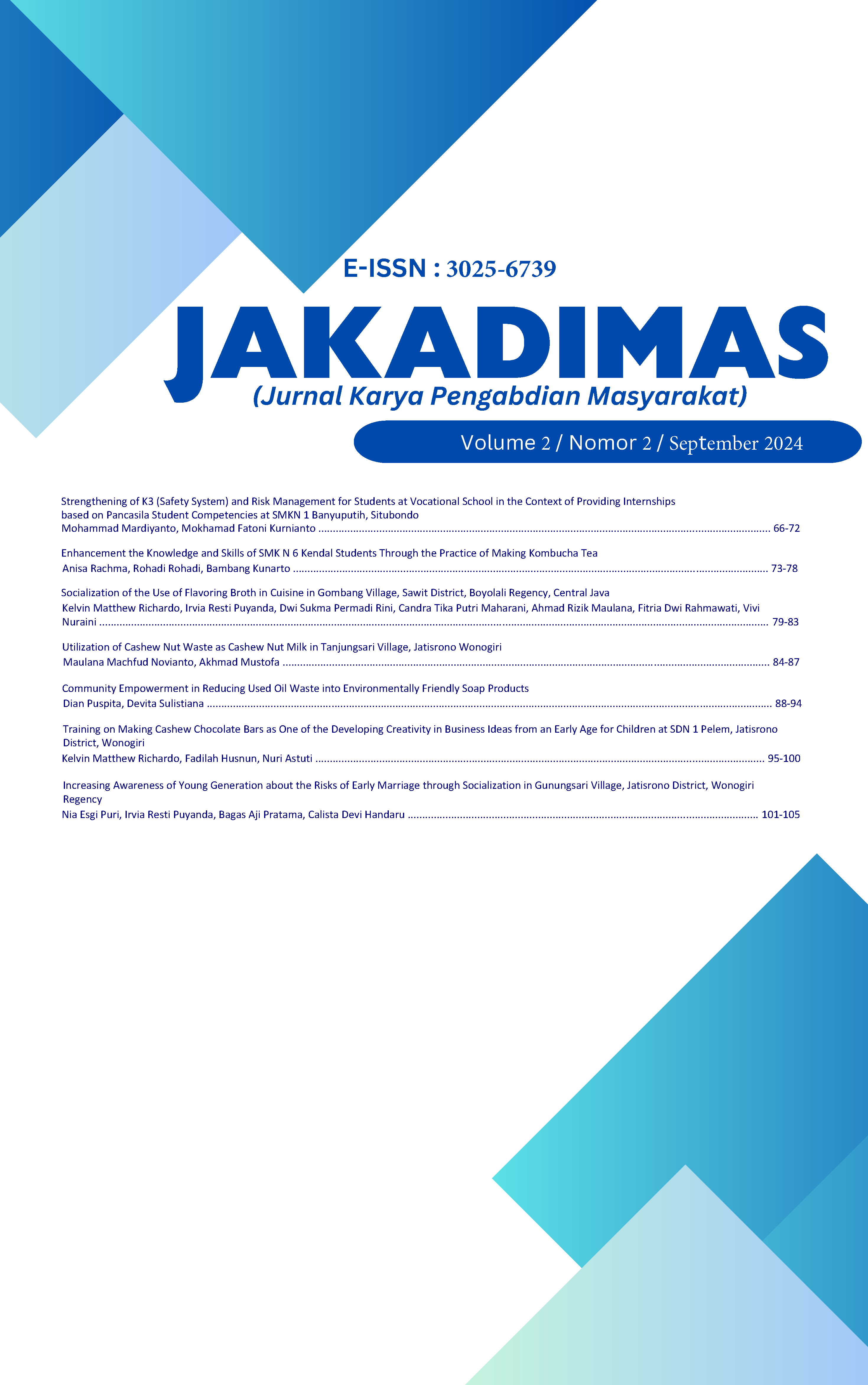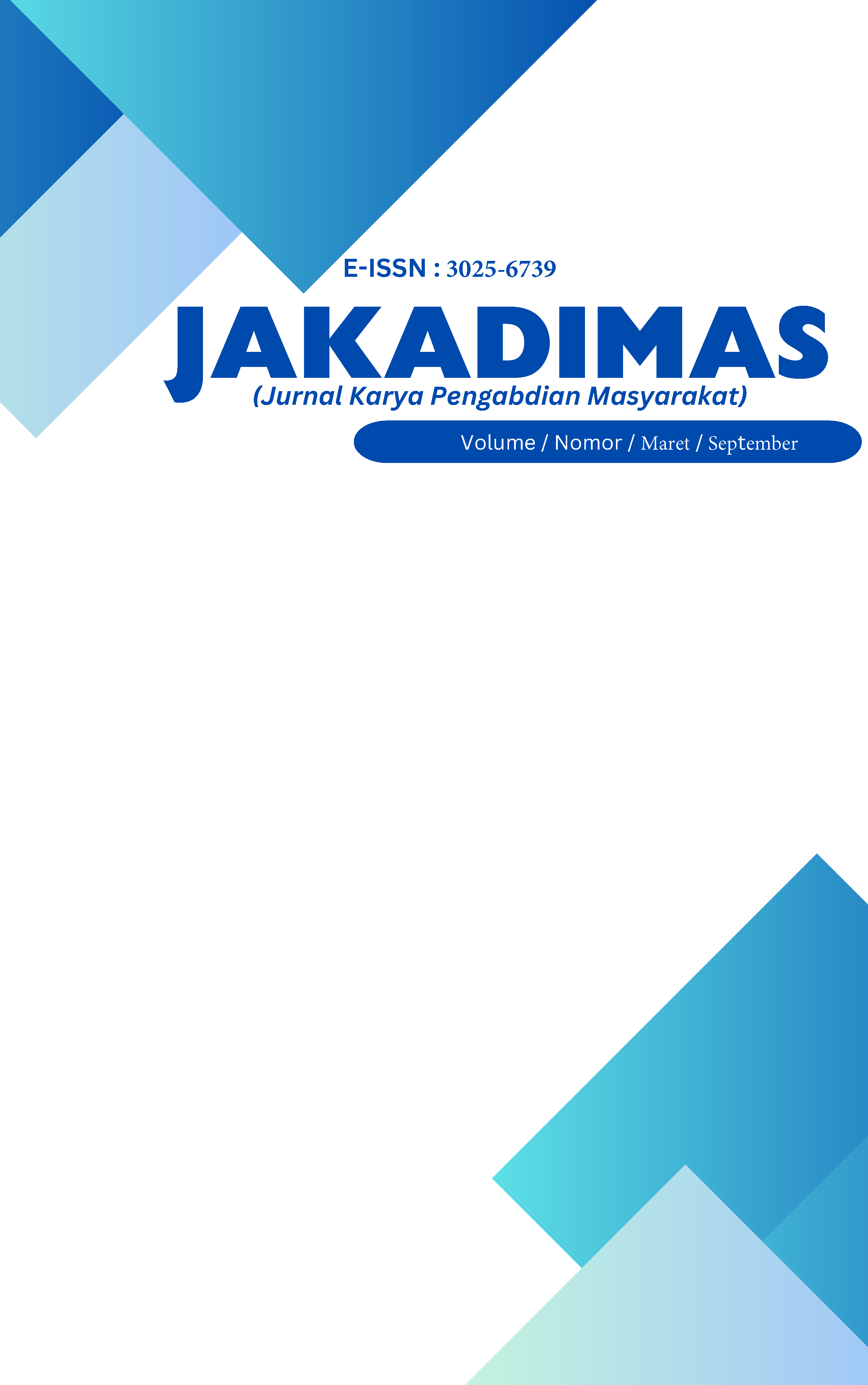Strengthening of K3 (Safety System) and Risk Management for Students at Vocational School in the Context of Providing Internships based on Pancasila Student Competencies at SMKN 1 Banyuputih, Situbondo
Penguatan Sistem K3 dan Manajemen Resiko kepada Siswa-siswi SMK dalam Rangka Pembekalan Magang berbasis Kompetensi Pelajar Pancasila di SMKN 1 Banyupitih Kabupaten Situbondo
DOI:
https://doi.org/10.33061/jakadimas.v2i2.11154Keywords:
K3, risk management, and dangers controlAbstract
The introduction of K3 (Safety System) is one of the important aspects that must be known and implemented for students who will carry out apprenticeships. The implementation of the K3 system is closely related to the implementation of risk management. The implementation of the K3 system and risk management aims to identify potential dangers and control potential dangers and risks that exist in the industry. The aim of implementing this socialization is to strengthen students' abilities in identifying potential dangers and determining the appropriate type of control. The implementation of this socialization consists of 4 (four) stages including: 1) delivering material, 2) providing case studies in the form of teaching aids. 3) give assignments to students regarding potential dangers and control systems in the school environment, and 4) carry out evaluations and assessments regarding the work objects of each student. It is hoped that this activity will be able to provide students with an overview of potential hazards and their control systems in a specific and measurable manner.
References
Aini, M, N. & A, Nuryono, (2020). Analisis bahaya dan resiko kerja di industri pengolahan teh dengan metode HIRA atau IBPR. Journal of Industrial and Sistem Engineering (JIES). 1(1), 65-74
Amelia, N, A., M, A, B, Syukur. & D, R, Afandi. (2021). Pengaruh komitmen, disiplin kerja dan komepetensi terhadap pelaksanaan K3. Jurnal Pengembangan Wiraswasta. 23(3), 203-212
Azhari, F, M. & I, Mustofa. (2023). Strategi meningkatkan penggunaan Alat Pelindung Diri (APD) pada pekerja proyek konstruksi di tulungagung. Engineering and Technology International Journal. 5(3) 1-8
Bangonang, R, J., W, B, S, Joseph., & F, L, F, G, Langi. (2022). Analisis dan prediksi tren kecelakaan kerja di indonesia. Jurnal Lentera: Penelitian dan Pengabdian Masyarakat. 3(2), 75-78
Moon, H., B, Kim., J, Lee., H, Cho., S, Hwang. dan Y, Ahn. (2020). Developing risk breakdown structure for nuclear power plant decommissioning project in korea focusing on radioactive concrete dismantle. International Journal of Sustainable Building Technology and Urban Development. 11(4), 269-281
Mustiksari, A, F. & D, Ariyanti. (2023). Analisis dampak sistem pengelolaan keselamatan dan kesehatan kerja terhadap produktivitas karyawan di PT XYZ. Jurnal Manajemen Bisnis dan Industri. 9(2), 90-105
Ramesh, R., M, Prabu., S, Magibalan. & P, Senthilkumar. (2017). Hazard identification and risk assessment in automotive industry. International of ChemTech Research. 10(4), 352-358
Salianto., M, Akhyar., & M, Subhan. (2022). Evaluasi penerapan Kseleamatan dan Kesehatan Kerja (K3) berdasarkan Sistem Manajemen Keselamatan dan Kesehatan Kerja (SMK3): studi literature. Nautical: Jurnal Ilmiah Multidisplin. 1(5), 396-399
Sidauruk, S., Sutomo, A., & H, Budiyono. (2014). Komitmen Manajemen, Pengetahuan K3 dan Sikap K3 dengan Penerapan SMK3 pada Pekerja. Jurnal Media Kesehatan. 8(2), 100-204
Wati, D, I, R. & Susilawati. (2023). Literature Review: Hubungan penerapan program sistem manajemen kesehatan dan keselamatan kerja dengan produktivitas kerja karyawan. ARRAZI: Scientific Journal of Health. 1(1), 27-33
Downloads
Published
How to Cite
Issue
Section
License
Copyright (c) 2024 Mohammad Mardiyanto, Mokhamad Fatoni Kurnianto

This work is licensed under a Creative Commons Attribution-ShareAlike 4.0 International License.
Authors who publish with this journal agree to the following terms:
- Copyright on any article is retained by the author(s).
- The author grants the journal, right of first publication with the work simultaneously licensed under a Creative Commons Attribution License that allows others to share the work with an acknowledgment of the work’s authorship and initial publication in this journal.
- Authors are able to enter into separate, additional contractual arrangements for the non-exclusive distribution of the journal’s published version of the work (e.g., post it to an institutional repository or publish it in a book), with an acknowledgment of its initial publication in this journal.
- Authors are permitted and encouraged to post their work online (e.g., in institutional repositories or on their website) prior to and during the submission process, as it can lead to productive exchanges, as well as earlier and greater citation of published work.
- The article and any associated published material is distributed under the Creative Commons Attribution-ShareAlike 4.0 International License








